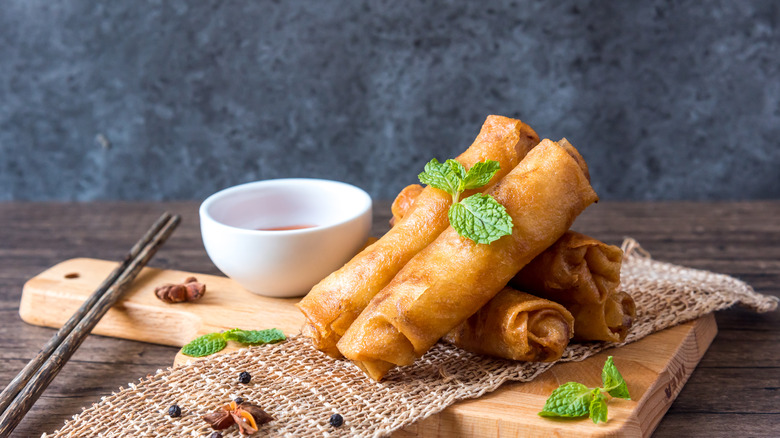The Overlooked Difference Between Egg Rolls And Spring Rolls
If you're a fan of foods that are mouthwateringly savory, you're likely no stranger to the wonders of Asian cuisine and all its umami goodness. It's common to have either egg rolls or spring rolls with your meal, whether you've just ordered the best Chinese takeout or you need to munch on a small appetizer before your main course arrives. Maybe you prefer one over the other, or maybe you've never really thought about it before and just assumed they are both one and the same. There are actually a few key distinctions between egg rolls and spring rolls that you might not have realized, like their cooking method, ingredients, and textures. Place them side by side and it's easy to spot the differences if you know what to look for.
Spring rolls have thin, sometimes transparent, wrappers made of rice flour and are either baked or lightly fried. Hence the smooth texture that flakes right into your mouth once you take a bite. Egg rolls, on the other hand, are made with wheat flour, so they give you that satisfying, audible crunch when eaten. This is due to a much thicker, egg-coated wrapping that's fried to golden perfection, which is why its texture is more bubbly and dense than that of spring rolls. Now that you can recognize each type of roll by sight, it's time to dive into what makes them each different on the inside.
Egg roll fillings are cooked, spring roll fillings are not
Besides differentiating them by appearance alone, there is still one defining difference between egg rolls and spring rolls that is often overlooked. Egg rolls can contain pork, chicken, or shrimp that is mixed in with cooked cabbage and other veggies. The self-taught Chinese-Indonesian cook behind IzzyCooking explains that the thickness of an egg roll's wrapper is what makes it a perfect vessel for cooked ingredients and meat. Then you have spring rolls, which are meatless and typically have fresh veggies that are cold and uncooked, all thinly veiled within its wrapper.
These may be the standard methods for preparing crunchy egg rolls and fresh spring rolls, but these dishes have been around for long enough to have evolved into all kinds of tasty variations. For instance, spring rolls in the Philippines do include meat, along with a tangy pineapple sauce. Thai spring rolls aren't fried at all, and are drizzled in peanut sauce. South Korea literally just rolls an egg up for their version, called Gyeran-mar, stuffing it with roasted seaweed and even tuna. When following your delicious egg roll recipe, you actually don't even need to include eggs, despite their given name. They've both become quite versatile foods over time, and now that you can tell them apart with ease, you can experiment with lots of creative flavor combos.

